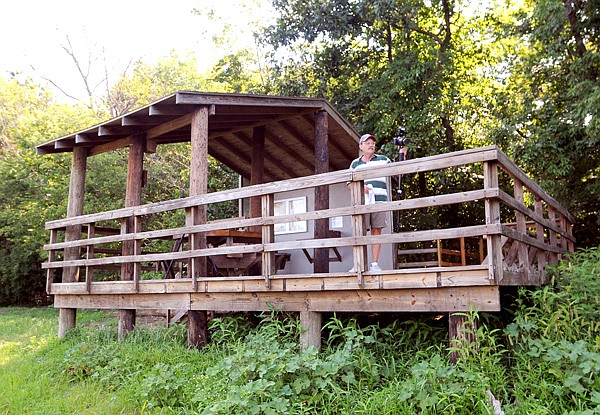Trail not just for eagle watching
Trail packs punch for wildlife observers.
Terry Stanfill, caretaker for the Eagle Watch Nature Area, watches for wildlife photo opportunities from the observation platform at the end of the Eagle Watch Trail.
Wednesday, August 15, 2012
GENTRY — There’s no need to hike 10 miles to see a menagerie of wildlife when critters furred and feathered can be seen in an easy one-mile walk.
The Flint Creek Power Plant Eagle Watch Nature Trail near Gentry packs more habitat and more wildlife along its one-half mile tread than longer paths.
At the end of the line there’s a lakeside pavilion to relax, have a picnic and enjoy scores of waterfowl, songbirds and, during winter, one of the area’s largest concentrations of bald eagles.
The one-mile out and back hike is level and easy on the feet. Mulch is laid down over much of the path. A walk takes visitors past wildlife food plots,meadows, through lush forest and along 500-acre SWEPCO Lake.
The trail meanders through a slice of1,500 acres at the Flint Creek Power Plant near Gentry. The Eagle Watch Nature Trail parking area and trailhead is 1.3 miles west of Gentry on Arkansas 12.
It’s free and open to everyone.
Trail Tour
What better guide to show off the trail than Terry Stanfill, recently retired from a career at the coalfueled electric plant operated by AEP Southwestern Electric Power Co.
Stanfill lives in Coon Hollow near Decatur and is a dedicated steward of the Eagle Watch Nature Trail. He organizes nature activities and field trips on the grounds for nature groups, school groups and others.
A hiking trail at a power plant? How come?
“When bald eagles started showing up in good numbers on the lake in the 1980s, they were a big attraction,” Stanfill said during a hike on July 13. “Swepco decided to give the public a place to see the eagles. That’s how the trail got started.”
The trail opened in September 1999.
Because the path is a top destination for seeing eagles, “people think of this as a place to come in the winter. But people who don’t come in the spring and summer are missing out,” Stanfill said.
Visitors can start with a stroll through a butterfly garden rife with native wildflowers, grasses, buzzing bees and fluttering butterflies.
Students from Gentry schools planted the garden. Boy Scouts from Troop 34 in Gentry helped build the trail, and projects by Eagle Scout candidates have improved it.
Interpretive signs along the way identify various trees and plants. Little Flint Creek runs near the trail and eventually enters the lake.
“We’ve even got our own cantaloupe patch,” Stanfill pointed out. Sure enough, under a sign at the entrance, was a viney patch with about eightcantaloupe that waited to be picked. How the patch came to be is a mystery.
“I don’tknow if someone threw some seeds out of their car or if someone was here eating cantaloupe,” Stanfill said.
On a side note, your faithful outdoors reporter took one of the cantaloupes home to eat. Not quite ripe.
Photography Stop
Stanfill is an accomplished nature and wildlife photographer whose pictures regularly grace this newspaper’s outdoors pages. His yard and the Eagle Watch Nature Trail are frequent photography destinations.
“There are six or seven serious wildlife photographers who use this place,” Stanfill said. He toted a camera and monopod on our hike.
“Let me see if I can get a picture of this scissortailed fly catcher,” he said. Too late. The long-tailed bird gave Stanfill the slip.
Bluebird boxes built by students have fledged young along the trail. Schools in Gentry and Siloam Springs have done hours of work at the trail. Each spring around EarthDay, students gather with Stanfill to plant wildflowers and food plots, construct bird houses and spruce up the place.
After the work, there’s pizza for all.
If there’s one user group the trail attracts most, it’s birders. Stanfill is one of them.
“Our list is up to 174 species we’ve seen here,” Stanfill said.
When we approached the lake, Stanfill counted 10 white egrets near the shore. Then it was like he’d spotted a pot of gold. Seeing a neotropic cormorant was better.
“There have only been two sightings of them in Northwest Arkansas and both of them were here,” he said.
Joanie Patterson of Goshen had her powerful spotting scope set up at the wildlife viewing pavilion. Her glass was aimed at the rare cormorant. While Stanfill had a looksee, she searched the area with binoculars for more birds.
“I love the fact that there’s such a variety of birds here,” Pattersonsaid. “You never know what you’re going to see. I love that it’s kept natural. Look at this. This is wonderful.”
Stanfill noted that when the eagles are in during winter, “you might see 30 on a good day. Then the next day you might not see any.”
The 1,500 acres around the Flint Creek PowerPlant are certified with the Wildlife Habitat Council, a group that works with corporations to enhance their property for wildlife. Certification must be renewed every three years.
It’s summertime and the living isn’t so easy in this hot season, but the walking and wildlife watching are a cinch at the Eagle Watch Nature Trail.
News, Pages 3 on 08/15/2012
